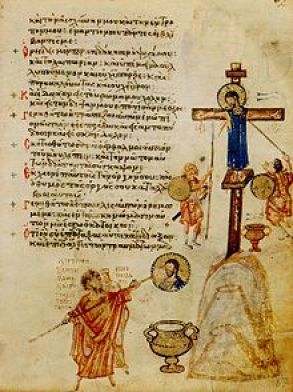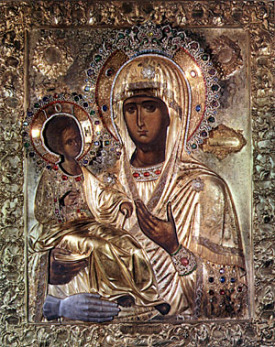From the centrality of the icon to its rejection then to its justification
4th and 5th century Romano-Byzantine culture considered symbolic representations of Christ and the Trinity after a rule complying with biblical references: "You shall not make for yourself an image in the form of anything in heaven above or on the earth beneath or in the waters below. You shall not bow down to them or worship them” (Exodus); “Yet a time is coming and has now come when the true worshipers will worship the Father in the Spirit and in truth, for they are the kind of worshipers the Father seeks. God is spirit, and his worshipers must worship in the Spirit and in truth.” (John 4: 23-24). So it is a purely symbolic value that pertained to three animals: the lamb, representing the crucifixion of an innocent Jesus, the dove, representing the Holy Spirit and the fish representing the Christ since the first letters of the Greek word “ichtus” (fish) abbreviate “Iēsous Christos, Theou Yios, Sōtēr”, which translates as "Jesus Christ, Son of God, Saviour".
During the two following centuries, however, icons representing the human figure grew in importance both in the political and the religious realms. Christian worshipers saw in it a way to come closer to the divine, an expression of piety commended by part of the clergy. Meanwhile, in the secular world, the political power was resorting to figuration notably in the instance of coinage.

 Informations[1]
Informations[1]Leo III would break with this trend. In 725, he launched a campaign against images, seeking the support of the religious authorities. He rallied some bishops, John of Synnada, Constantine of Nakoleia, Thomas of Claudiopolis to his cause; as against that, Patriarch Germanus[2] refused to sign the decree condemning figurative images. However, on 7 January 730, he was forced to resign. Until 741, the Emperor pursued his policy without the use of force. His son, Constantine went one step further with the council of Hieria, which he hosted in a palace close to Constantinople and where the council fathers gathered – in the conspicuous absence all leading patriarchs (Antioch, Jerusalem, Alexandria and Rome). Its acts, the original text of which has been lost, offer the following doctrinal position: when the Holy Eucharist is put across as the “body of Christ”, figurative images are in no position to account for Christ's divine nature. The Council Fathers nevertheless tolerated the cross as a symbol. This iconoclastic policy must be read within the context of a clash between the emperor and the monks who disputed his claim to declare himself the representative of Christ on earth. Constantine led a full frontal assault on the signs of monastic status. Their beards were burned with pitch, their black robes were used to darken their character, monastic property was confiscated and sometimes sold.

 Informations[3]
Informations[3]Empress Irene was to put paid to these measures and bolstered an iconodule reaction endorsed by clergy dignitaries. John of Damascus[4] disputed the emperor's right to interfere in theological matters, in which he had no competence. He justified the use of icons, explaining that the faithful's worship is not focussed on the physical object proper but on the person represented therein. This conception was validated by the clerics participating in the second Nicaean Council (24 September-23 October 787). The council fathers condemned the positions adopted at the Council of Hieria and upheld the use of icons as complement to the proclamation of the word steeped in Scripture. It castigated the theological ignorance of the iconoclasts and defended the legitimacy of holy images and their value in worship. In the short term, Nicaea II was a failure. Carolingian clerics rejected its findings, whilst the Byzantine remained caught up in internal strife. Soon enough, the iconoclasts regained the upper hand over the iconodules. To that end Leo V relied on Antony, Bishop of Sylaion[5] and John VII of Constantinople[6] whose action would later be illustrated. This second wave lasted up to 842, after which date the game is over for the iconoclasts. Whereupon a flourishing of the arts made up for lost time and yielded some works ascribed to figures who had defended the role of icons in the churches.

 Informations[7]
Informations[7]
 Informations[8]
Informations[8]





